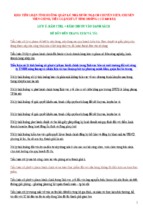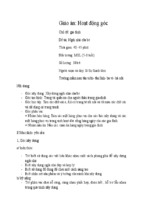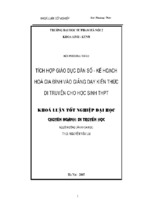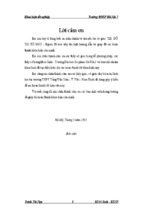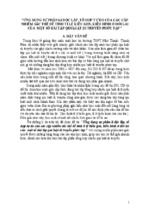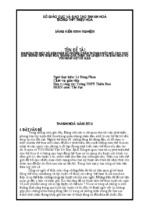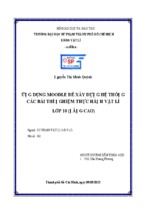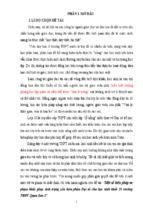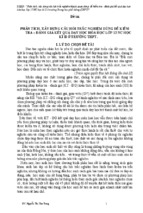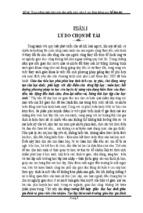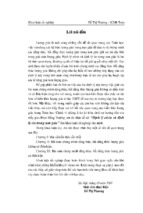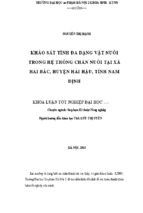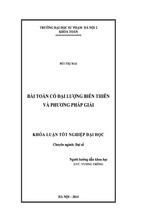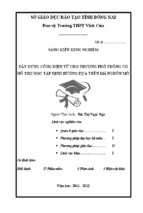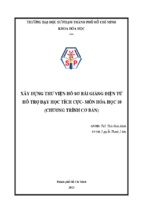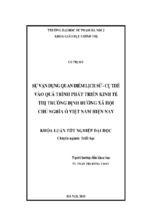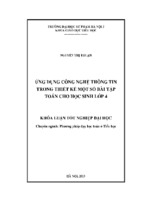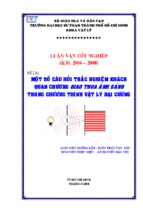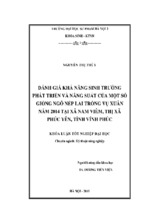THANH HOA TRAINING& EDUCATION DEPARTMENT
TRIEU SON TRAINING & EDUCATION DIVISION
TEACHING EXPERIMENT
IMPROVING THE WAY TO PRONOUNCE
ENGLISH CONSONANTS OF GRADE- 6 STUDENTS
Writer: Nguyễn Thị Như Quỳnh
Position: Teacher
School: Thi Tran Trieu Son Secondary School
Subject: English
THANH HOA - 2019
CONTENTS
Number
1
Content
1. INTRODUCTION
1.1. Justification of the research
1.2. Aim and objectives of the research
1.3. Scope of the research
1.4. Method of the research
- Subject of the research
- Data collection instrument of the research
- Data analysis procedure of the research
Page
2
2
3
3
3
2. DEVELOPMENT
2
2.1. Theoretical background
2.1.1. Definition of consonants in English
2.1.2. The basic consonants in English
2.1.3. Classification of English consonants
2.1.3.1. According to place of articulation
2.1.3.2. According to the manner articulation
2.1.3.3. According to voicing
2.2. Real situation and suggested solution
2.2.1. Possible causes
2.2.1.1. Lack of awareness of the importance
2.2.1.2. Teachers’ neglect of pronunciation
2.2.1.3. Mother tongue interference
2.2.2. Suggested solution
Doing pronunciation exercises
a. Distinguishing sound exercises
b. Find the odd sounds
c. Matching exercises
3
3. CONCLUSION
4
7
9
9
9
10
10
14
3.1. Conclusion
3.2. Request
4
5
REFERENCES
THE EXPERIMENTS HAVE BEEN
REGARDED
16
17
INTRODUCTION
1.1. Justification of the research
We all know that during the time of studying English, there are many
pronunciation errors that secondary students learning English tend to make such
as word and sentence stress, intonation, length of vowel sounds, ending sounds
and linking sounds, etc. To help better English pronunciation for students who
learn English at secondary school, it's is essential to do a search on most typical
pronunciation problems of Vietnamese students, which is, in this research, errors
with consonant sounds.
For secondary students, who have to learn English as their main subject,
and then take exams in which English is one of the compulsory subjects. It's
extremely significant to realize their pronunciation errors. They cannot selfcorrect their English pronunciation so they are not confident enough to
communicate in English. It’s obvious that there are some students noticing their
pronunciation errors when their pronunciation erroneously, others, on the other
hand, don't recognize their problem with pronunciation English words.
Although there are common errors made by learners, not all the teachers
pay attention to them. The conclusion partly from personal observation supports
this research. It is possibly because some sounds are not pronounced so clearly
as other sounds in an utterance so they are less noticed by both learners and
teachers. In addition to this, there have not been many studies on these particular
pronunciation errors so far at high level. Only studies about general speaking
and pronunciation errors were carried out, which appears to have failed to
emphasize the main pronunciation problem of Vietnamese students of English.
I believe that a study on English pronunciation errors will help students
become well aware of their pronunciation problems to which they might not
have paid any attention before. It’s also the help for some teachers in teaching
pronunciation at schools if the study can recommend some solutions to help
students practice pronunciation individually and in group. From the reasons
mentioned above, I have decided to carry out this study entitled "Improving the
way to pronounce English consonant sounds of grade-6 students”.
1.2. Aim and objectives of the research
English phonetics is important as it lays basis for effective oral
communication. As far as I know, students of English at primary schools are not
taught phonetics(and students at secondary schools who learn new curriculum
are taught some sounds) and mostly taught by nonnative- English teachers.
Classes in Viet Nam are big so it is not suitable for teachers and students
to practice pronunciation.
With the hope of getting more comprehensive and specific understanding
of English consonants, finding out common consonants pronunciation mistakes
faced by Vietnamese, my study focuses on:
Introducing the basic theories of English and their difficulties.
Particularly, giving the principles of consonants pronunciation and raising the
learner awareness of English pronunciation by giving specific evidences,
1
examples, figures, pictures may make learners try to pronounce like native
speakers.
Providing some exercises may be very helpful for learners in English
pronunciation as well as in English communication today.
1. 3. Scope of the research
The study focuses on English errors made by students in grade 6, I do not
have an ambition to cover all the students' problems with English pronunciation.
Only the pronunciation errors with some typical consonants made by the
students in grade 6 are investigated.
1. 4. Method of the research
Subjects of the research
This school year, I teach two classes in grade 6 with 66 students - 6A, 6B
at Thi Tran Trieu Son secondary school but I choose 50 students participating in
this study. They are about the same age; both genders and they come from many
villages in Trieu Son district.
Data collection instruments of the research
Information in the study is collected in a natural way. In order to analyze
the pronunciation errors that students in grade 6 make in their utterances, I have
been observing in their lessons in class for many years and write down students'
errors. Then I analyze at home with the help of the attached CD and typescripts
in the course book " Pronunciation Made Simple" provided by an American
teacher Ms. Mindy and many video clips about pronunciation on YouTube.
Data analysis procedure of the research
Firstly, I took students' errors, checked whether they knew how to
pronounce the words or not, I also counted how many students selected each
pronunciation.
Secondly, I compared students' errors with the guide books, sample
videos.
Thirdly, I asked my colleagues about how to pronounce the words in the
survey and the errors that students made.
2. DEVELOPMENT
2.1. THEORETICAL BACKGROUND
This first part will provide readers with the related theoretical background
of the study by introducing some key concepts necessary for the best perception
of this research as well as the review of previous studies related to the topic.
Central concepts chosen to be clarified in this part are English pronunciation,
Standard pronunciation, English pronunciation Errors Aspects of pronunciation
such as the articulator and English sounds.
Since the research have a strong desire to investigate the pronunciation
errors in English, the definition of English pronunciation is especially important.
Commonly speaking, pronunciation is simply put as "the way in which a
language is spoken"[1]
2
THANH HOA TRAINING& EDUCATION DEPARTMENT
TRIEU SON TRAINING & EDUCATION DIVISION
There are 44 sounds in English. They are divided into two groups: 20
vowel sounds including 12 pure vowels, 8 diphthongs and 24 consonants. Some
years ago, I had a study on vowel sounds so this time I just focus on consonants.
2.1.1. Definition of consonants in English
In articulator phonetic, a consonant is a speech of sound that is articulated
with complete of partial closure of the upper vocal tract; the upper vocal tract is
defined as that part of vocal tract lying above the larynx.[2]
Consonants are formed by interrupting, restricting or diverting the airflow
TEACHING EXPERIMENT
in a variety of ways.[3]
2.1.2. The basic consonants in English include:
/b/, /p/, /k/, /g/, /t/, /d/, /v/ /f/, /s/, /z/, /h/, /0/, /d/, /m/, /n/, /l/, /r/, /w/, /y/,
/g/, /Ɵ/, /ʒ/, /ʃ/, /ʧ/,THE
/ʤ̄/ WAY TO PRONOUNCE ENGLISH
IMPROVING
2.1.3. Classification of English consonants
CONSONANT
SOUNDS OF GRADE- 6 STUDENTS
There are three ways of describing consonant sounds:
1. The place of articulation
2. The manner of articulation
3. The voicing
2.1.3.1. According to place of articulation
In English, there are six places in the mouth where the airstream is obstructed in
the information of consonants.
In this study, we will discuss each consonant in terms of the articulators
involved and the place in the mouth where the articulators cause an obstruction
of the airstream.
*Sounds made with the lips
+ Both lips-bilabial: /p/, /b/, /m/
Pronounce the words “pat”, “bat” and “mat”, paying attention to the way
Writer:
Thị Như
the first consonants
of eachNguyễn
word is made.
TheQuỳnh
first sound in each of these words
Position:
Teacher
is made with the two lips coming together and touching momentarily. The
Tran
Trieu
obstruction of theSchool:
airstreamThi
thus
occurs
at theSon
lips.Secondary School
Subject:
English
The sound /p/, /b/,
and /m/ are
referred to as bilabial sounds because the two(bi-)
lips (labial) are involved in their production
THANH HOA - 2019
Figure 1: The position of the lips in
the production of /p/, /b/, and /m/
Figure 2: The position of the teeth
and lips in the production of /f/, /v/
3
+ Lower lip and upper teeth - labiodental: /f/, /v/
Produce the words “fat” and “vat”, again paying attention to the way the
first sounds of these words are formed. The initial sounds of these words are
made with the top teeth touching the bottom lip. Therefore, the obstruction of
airstream occurs not because the bottom lip and the top lip come together.
Again, the phonetic symbols for these two sounds are the same as the English
letters. We use the symbols /f/ and /v/ to represent the initial sounds of ‘fat’ and
‘vat’. The sound /f/, /v/ are referred to as labiodental sounds because the lips
(labio) and the teeth (dental) are involved in their production.
* Sounds made with the tip of the tongue
+ Tip of the tongue and the teeth - interdental: /θ/ and /ð/
Pronounce the words “think” and “this”, paying attention to the way the
first consonant sounds of these words are formed. With first consonant sounds
of these words the obstruction of the airstream occurs because the tip of the
tongue is between the teeth or just behind teeth. The phonetic symbols for
these sounds are not the same as the English letters. The “th” sound in “think”
and “this” are represented by symbol /θ/ and /ð/. The sound /θ/ and/ð/ are
referred to as interdental sounds because the tongue is placed between (inter) the
teeth (dental).
The two th sounds are notoriously difficult for second language learners
because they are not common sounds in many of the world’s languages. While
not many words in English contain the /ð/ sound as in ‘this’, the words that do
contain in this sound are among the most frequently used words in the English
language. For example, the words these, those, then, than, them and their all
begin with the /ð/ sound. The /ð/ sound is also found in such common words as
without, sunbathing , mother and brother. Thus, how important this sound is in
English.
+ Tip of the tongue and the tooth ridge - alveolar: /t/, /d/, /n/, /l/, /s/, /z/, /r/
Other English sounds made with the tip of the tongue include the initial
sounds of ‘tip’, ‘dip’, ‘nip’, ‘lip’, ‘sip’, ‘zip’, and ‘rip’. When you pronounce the
initial consonant of these words, you should feel the tip of your tongue touching
the roof of your mouth just behind upper teeth with /t/, /d/, /n/, /l/ and
approaching the tooth ridge with /s/, /z/, /r/. These sounds are referred to as
alveolar because the tongue either touches or approaches the alveolar ridge in
their production.
Figure 3: The position of the tongue
the production of /θ/ and /ð/
4
Figure 4: The position of the tongue
the production of /t/, /d/, /n/, /l/
*Sound made with the blade of the tongue
+ Blade o the tongue and the hard palate - alveolar- palate: /ʒ/, /ʃ/, /dʒ/, /tʃ/
When you pronounce the words wash and pleasure, concentrating on the
position of the tongue in the production of the final sounds. These sounds are
made with the blade of the tongue approaching the hard palate just behind the
tooth ridge. The phonetic symbols for these sounds are not the same as the
English letters. We use the symbol /ʃ/, to represent the final sound of wish and
the symbol /ʒ/ represent the final sound of pleasure. One other important aspect
of the pronunciation of /ʒ/, /ʃ/ involves the lips. Notice that the lips are rounded
when you pronounce these sounds.
There are two other sounds that are made with the blade of the tongue at the
hard palate. These are initial consonants in the words church and jug. We
use the complex symbol /tʃ/ for the initial sound in the word church and /dʒ/ for
the initial sound in the word jug.
The sound /ʒ/, /ʃ/, /dʒ/, /tʃ/ are referred to as alveolar palatal sounds because the
tongue is just behind the alveolar ridge at the hard palate in the production of
these sounds.
Figure 5: The position of the tongue Figure 6: The position of the tongue
in the production of /ʒ/, /ʃ/, /ʤ/, /ʧ/
in the production of /k/, /g/, /ŋ/
* Sound made with the back of the tongue
+ Back of the tongue and soft palate- velar: /k/, /g/, /ŋ/
When you pronounce initial sounds of cat, goal and monkey, the
back part of your tongue touches the back part of your mouth momentarily,
causing the obstruction of the airstream.
The sounds /k/, /g/, /ŋ/ are referred to as velar sounds because they are made
with the back of the tongue rising to touch the soft palate or velum.
Places of articulation
Bilabial Labiodentals Interdental Alveolar Alveolarpalatal Velar
p, b, m
f, v
/θ/, /ð/
t, d, l, n, s , /ʒ/, /ʃ/, /dʒ/, /tʃ/
/v/
z,r
The places of articulation for consonants can be summarized as following:
5
2.1.3.2. According to manner of articulation
Manner of articulation refers to the interaction between the various articulators
and the airstream. There are 7 groups of consonants classified according to
manner of articulation:
*Complete obstruction of the airstream - stops
Are the sounds made by the air that passes from the lung into the mouth
can be completely stopped because the lips or tongue actually touch some parts
of the upper mouth, and then escaped strongly causing a closure. Consonants
that involve this complete blockage of the airstream are called stops. The initial
sounds of pill and bill, tall and dull, kind and ground are all stop consonants.
Notice that the place in the mouth where the airstream is blocked differs with
these three pairs of sounds. With /p/ and /b/, the air is blocked because the two
lips come together. With /t/ and /d/, the air is blocked because the tip of the
tongue touches the tooth ridge. With /k/ and /g/, the air is blocked because the
back of the tongue touches the soft palate.
The stop consonants of lip (bilabial) /p/ and /b/
Tooth ridge (alveolar) /t/ and /d/
Soft palate (velar) /k/ and /g/
Figure 8: Complete blockage of the Figure 9: Partial blockage of the airstream
airstream as in the stops /t/ and /d/
as in the fricative /s/ and /z/.
+ Partial obstruction of the airstream - fricatives
Some consonants in English do not involve a complete stoppage of the
airstream but rather a partial obstruction. This partial obstruction results from
the lips or the tongue coming close to some part of the upper mouth. These
consonants are called fricative because the sounds produced by the forcing the
airstream through a narrow opening between the lips and the teeth or the tongue
and the teeth.
The fricative consonants of English
Lower lip/ upper teeth (labiodental) /f/ and /v/
Teeth (interdental)
/θ/ and /ð/
Tooth ridge (alveolar)
/s/ and /z/
Hard palate (alveolar palate)
/ʃ/, and /3/
+ Sounds made with the air escaping through the nose - nasals
All of the consonants sounds that we have discussed up to this point are
made with air passing through the mouth. Nasal sounds, on the other hand, are
6
made with air passing through the nose. Air is blocked in the mouth in the same
way as it is for stop consonants. However, the soft palate is lowed allowing air
to escape through the nose.
Figure 10: The position of the
Figure 11: The position of the
velum in the production of /k/
velum in the production of nasal
and /g/
consonant /ŋ/
There are three nasal consonants in English: /m/, /n/, and /ŋ/ as in ram,
noon, rang. These three sounds differ in terms of place of articulation. The /m/
is produced when the two lips touch, the /n/ is produced when the tip of the
tongue touches the tooth ridge and the / q/ is produced when the back of the
tongue touches the soft palate. In each case, this contact prevents air from
escaping out of the mouth.
*Lateral
Lateral sound is made with the tip of the tongue touching the tooth ridge and the
air passing through the mouth over the sides of the tongue: /l/
For some speaker of English, the /l/ may be made with air passing out of the
mouth over one side of the tongue only. Because the air passes out the side of
the mouth, the /l/ sound is referred to as a lateral consonant.
* Retroflex
Retroflex sound is made with the tip of the tongue slightly curled back in
the mouth. Pronounce the word right and prolong the initial consonant. You
should feel the tip of the tongue in a curled-back position. You may also feel
some backward movement of the tongue and some rounding of the lips. Upon
pronunciation of the vowel sound in right, the tongue is uncurls. Because the
tongue is curled back during the pronunciation of the /r/ sound, it is referred to
as retroflex consonant.
* Semivowel
Other consonant sounds of English produced with little turbulence in the
airstream are the initial sounds of the words wet and yet. These two sounds are
often called semi-vowels because they are made with a relatively wide opening
in the mouth. In the pronunciation of the /w/ the lips are rounded and, at the
same time, the back of the tongue approaches the soft palate. Pronounce the
word wet, prolonging the first sound of this word. You should feel the lips
7
coming together and rounding slightly. It is difficult to feel the back of the
tongue approaching the soft palate but, in fact, this narrowing occurs as well.
2.1.3.3. According to voicing
Sounds that are made with the vocal cord are voice and sound made with
no vibration are voiceless. All of stops, fricatives and affricatives we have
discussed so far come in voiced/voiceless pairs. The nasals, laterals, retroflex,
and semi-vowels of English are all voiced.
Voiceless: p, t, k, f, s, θ, ʃ, tʃ
Voiced: b, d, g, v, ð, z, ʒ, ŋ, m, g, l, r, w, y
2.1.3.4. Consonant cluster
Consonant cluster is when two or more consonant together. It is divided into
initial and finial consonant cluster.
+ Initial cluster
Initial cluster is the cluster at the initial position of a syllable.
+ Initial two-consonant cluster of English
Stop
Fricative
Nasal
H
Lips Tooth Velum Lips Between Tooth Hard Lips
ridge
and Teeth
ridge plate
teeth
pl
tr
kl
fl
pr
ty
kr
fr
py
bl
tw
dr
ky
kw
fy
br
dy
by
dw
sl
sk
sy
sm
Tooth
ridge
ir
my
ny
hy
hw
sw sn
gr,gw
sp sf
st
+ Initial three-consonant cluster of English
These initial three-consonant clusters are usually produced with a pre-initial, an
post-initial and a /p/, /t/, k/ at the medium of pre-initial and post-initial cluster
spl
Spr
spy
str
sty
skr
sky
Skw
example splice spring spew string stew
screw skew Squirt
+ Final cluster
A final consonant cluster is the cluster at the final position of a syllable. The
consonants that occur in final cluster are not necessarily the same as which
occur in initial clusters.
8
2.2. REAL SITUATION AND SUGGESTED SOLUTION
2.2.1. Possible causes
English teaching is to enable learners to communicate in English, we can see
that communicative effectiveness depends on not only correct pronunciation of
these vowel and consonant sounds but also speakers themselves. Being able to
use the rhythm and intonation of English will enable speakers to be much more
intelligible than being able to pronounce vowel and consonants perfectly. It is
not unusual for teachers who are not native speakers of English to feel worried
about teaching pronunciation.
2.2.1.1. Lack of awareness of the importance of pronunciation
Being asked, students think that pronunciation does not much decide their
learning English; they claim that they can learn other skills well without a good
pronunciation.
The other skills that students said are listening, writing, reading…They do not
know that pronunciation is closely linked with listening comprehension,
spelling, grammar and reading. To ignore pronunciation is to ignore an
important part that can support the improvement of other skills. Pronunciation
plays a very important in both learning a language and communicating using
that language. Although students have good self- comments on pronunciation,
many students are still unconfident when speaking in English. They need to
understand that good pronunciation should be one of the first things that they
learn in English. They can use simple words and simple grammar structures to
say what they want instead of the advanced ones. Improper pronunciation has
certain negative effects on communication that may result in a failure in making
one understood by others.
2.2.1.2. Teachers' neglect of pronunciation
To give this reason, I do not mean that teachers of English have poor
pronunciation. I myself as well as other teachers of English have to teach many
big classes without modern equipment. We also ask students to practice in front
of the class, after finishing their presentation; the listeners(both teachers and
other students) have given comments. However, teachers paid attention more to
the best content and forgot to show the errors made in our students’ pronouncing
English words. It would be beneficial to the students if the teachers constantly
remind them of the need to practice pronunciation and help them correct errors.
2.2.1.3 Mother tongue interference
We all know that our students have own dialect so it is very difficult for teachers
to correct their errors.
2.2.2. Suggested solutions
Doing pronunciation exercises
Aim: New English curriculum has Pronunciation part. It is very
convenient for teachers to use exercises in this part to ask their students to
practice their pronunciation. Students can self- practice by doing the phonetics
exercises. These exercises will help students to recall and review the sounds
they have learnt and know the differences between the pairs of sounds.
9
a. Distinguishing sound exercises
Example 1: UNIT 7- TELEVISION (ENGLISH 6)
Exercise 4(P8)(4) Listen and repeat the words.
there
Thanksgiving
anything
them
weatherman
both
theatre
earth
feather
neither
than
through
Exercise 5(P8)(4) Which words in 4 have /θ/ and which words have /ð/? Listen again
and write them in the correct column.
/θ/
/ð/
In this exercise, I model the sounds /θ/ and /ð/ first. Then I ask Ss to
practice the /θ/ and /ð/ sounds together. Then I play the recording twice, ask my
students to listen to the recording, repeat the words and notice the sounds. Then
I ask some students to practice in front of the class, others listen and correct their
classmates’ errors (for more able students) or I have to point their errors (for
weaker students)
KEY:
/θ/
/ð/
theatre, Thanksgiving, earth, There,
them,
neither,
anything, both, through
weatherman, than, feather
Exercise 6(P8)(4) Tongue twister
Take turns reading the sentences quickly and correctly.
The thirty –three thieves are thinking of how to get through the security.
Example 2: UNIT 10- OUR HOUSES IN THE FUTURE (ENGLISH 6)
Exercise 4(P40)(4)- Listen to the chants. Write the words with the sounds
/dr/ and /tr/ in the table
Drops of the water
Little drops of water
Drip, drip, drip
Dripping from the cottage roof
On a rainy day.
I’d like to live in the countryside
I’d like to travel in the train
Along the track,
I’d like to drive a tractor
Through the hay.
KEY:
/dr/
drop, drip, dripping, drive
/tr/
countryside, track, train
10
b. Find the odd sounds
1. A. anything
B. both
2. A. weatherman
B. than
3. A. television
B. vision
4. A. she
B. wash
KEY: 1. C
2.C
3. D
c. Matching exercises
C. sunbathing
C. healthy
C. pleasure
C. sugar
4.D
D. through
D. feather
D. island
D. sound
Show words, sounds and ask students to match
Sounds
Words
1- /ŋ /
a- announce, castle, city, last
2- /ʃ/
b- creature, charity, natural, children
3- /ʧ/
c- gym, hedge, journey, energy
4- /s/
d- population, station, wish, sure
5- /ʤ/
e- monkey, thank, morning, interesting
KEY: 1-e 2d
3b
4-a 5- c
After three times teaching grade 6- the new English curriculum, I have
used the tips above and got some big achievement.
Number
Target sounds
Mispronounced sounds Number of errors
1
/ʧ/
/ʤ/
5
2
/s/
/ʃ/
7
Silent sound
5
3
/ð/
/ɵ/
4
3. CONCLUSION
3.1. Conclusion
Through the process of teaching, I have got some goals on improving the
way to pronounce consonant sounds of grade- 6 students. Students are aware of
consonants, how to pronounce them more correctly and they overcome
difficulties in learning English pronunciation. However, there are still certain
limitations such as: the practice procedure should have been done more
seriously and for a longer time.
I would like to receive more ideas from my colleagues.
3.2. Request
The process of teaching and learning English needs a lot of materials. So I
would like to:
+ For school
Facilitate for both of the teachers and students to apply the new
technology in teaching and learning English in order to get higher achievement.
+For teachers
Regularly learn, get information from books, Internet and exchange with
colleagues, and try to recognize and correct students’ mistakes.
+ For the leaders of the district, division
11
Provide more teaching materials for schools such as projectors,
computers, Wi-Fi.....
Organize classes for teachers to learn new methods, technologies and
exchange experience.
Organize more excellent exams for students to evaluate themselves.
The cooperation of all is the best way to get higher and higher
achievements.
Confirmaton of the head master
Trieu Son, April 15th 2019
I hereby commit that this document is my
original idea and is not copied from any
others’
Nguyen Thi Nhu Quynh
12
REFERENCES
N0
Name of the document
Oxford Advanced Learner's
Encyclopedic dictionary
Author
Jonathan
Crowther
Year
1992
Gimson’s pronunciation of
English.
Alan Gruttenden
professor
2000
4
How to teach pronunciation.
Kelly Grand
2001
Pearson
education
5
6
Internet webs
English 6 ( Teacher’s book)
Hoàng Văn Vân,
Nguyễn Thị Chi,
Lê Kim Dung....
2013
7
English 6 (Student’s book)
Hoàng Văn Vân,
Nguyễn Thị Chi,
Lê Kim Dung....
2013
Nhà xuất
bản giáo
dục Việt
Nam
Nhà xuất
bản giáo
dục Việt
Nam
8
Luận văn so sánh phát âm phụ
âm Tiếng Anh và phụ âm Tiếng
Việt -trường ĐH Dân Lập Hải
Phòng
Lê Hoàng Tuấn
2013
1
2,3
Publisher
Oxford
university
Press
Oxford
(sixth
edition)
13
1-
DANH MỤC
CÁC ĐỀ TÀI SÁNG KIẾN KINH NGHIỆM ĐÃ ĐƯỢC HỘI ĐỒNG
ĐÁNH GIÁ XẾP LOẠI CẤP PHÒNG GD&ĐT, CẤP SỞ GD&ĐT VÀ
CÁC CẤP CAO HƠN XẾP LOẠI TỪ C TRỞ LÊN
Họ và tên tác giả: Nguyễn Thị Như Quỳnh
Chức vụ và đơn vị công tác: Trường THCS Thị Trấn Triệu Sơn
TT
1.
2.
3.
Tên đề tài SKKN
Kết quả
Cấp đánh
đánh giá
Năm học
giá xếp loại
xếp loại đánh giá xếp
(Phòng, Sở,
(A, B,
loại
Tỉnh...)
hoặc C)
Phòng
B
2012- 2013
Nâng cao kĩ năng viết Tiếng
Anh cho học sinh cấp 2
Improving listening English
Phòng
for students at secondary
school
Improving the way to Phòng GD,
pronounce English vowel Huyện
sounds of grade-6 students.
A
2014-2015
A
2016- 2017
----------------------------------------------------
14
15
- Xem thêm -

